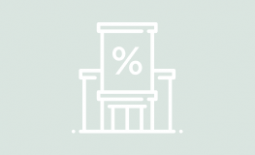Press release №39. The base rate remains unchanged at 9.25%
The dynamics of actual annual inflation, which amounted to 5.3% in September, is formed in accordance with the estimates of the National Bank made on the basis of the previous forecast. Inflation expectations of households are close to the level of actual inflation. At the end of 2019, inflation is expected to be at the level of 5.7-5.8%, that is, within the target corridor of 4-6%. On the horizon until the end of 2020 the inflation will remain within the target corridor of 4-6% despite the presence of inflation risks associated with the dynamics of prices for regulated services and certain types of food products.
The National Bank will make further decisions on the base rate taking into account the alignment of the actual and forecast inflation in order to achieve its target range.
In September 2019 the annual inflation slowed down to 5.3% compared to 5.5% in August. The core inflation calculated excluding price increases for vegetables and fruits, regulated services and energy resources also fell from 7.9% to 7.7%.
The slowdown in the growth of prices for non-food items to 5.4% and paid services to 0.7% in annual terms continues to have a restraining effect on inflation. The dynamics of nonfood inflation is characterized by the absence of a seasonal acceleration in the growth of prices for clothes, shoes and diesel fuel. Gasoline and solid fuel prices continued to decline (by 4.8% and 3.5% in annual terms, respectively). Regulated services have become 8.2% cheaper over the past 12 months.
Price increase in food items accelerated to 9.1% in September 2019, which is mainly due to the increase in domestic prices following global market prices amid the increased consumption of meat and cereals. Meat and meat products became 13.5% more expensive in annual terms, whereas the price for bakery products and cereals increased by 12.7%.
In September 2019, inflation expectations of households did not change significantly compared to August. On the horizon of the next 12 months they are estimated at 5.4%. According to the survey, the proportion of respondents expecting persisting or higher consumer price increase over the next 12 months fell to 54% (59% in August).
Consumer demand for goods and services is expanding. The growth of household real disposable income reached 6.7% in January-August 2019. These trends are reinforced by the budget spending on social support, wages and the expansion of consumer lending, that grew by 22.6% in annual terms in September.
Business activity has continued to grow. In January-September this year, the short-term economic indicator increased by 4.7% on the background of growth in construction by 13.5%, trade - by 7.6%, transport - by 5.5%, manufacturing and mining - by 3.5% and 3.1% respectively. The expansion of investments in January-September 2019 reached 9.7%.
The impact of external factors has not changed significantly compared to the previous decision. Dynamics of the oil prices remained moderate. Since the beginning of 2019, the average price level is formed at the level of 64 US dollars per barrel. Risks from global food markets remain balanced out. The value of the FAO Food Price Index in September was 170 points, remaining almost unchanged compared to the level of August. The decline in sugar prices was fully offset by the continued rise in vegetable oil and meat prices.
External monetary conditions are loosening. The Central Bank of Russia is pursuing a policy of reducing the key rate amid the decrease in actual and expected inflation associated with weak dynamics of domestic and external demand. Both the People's Bank of China and the European Central Bank continue to cut rates on their operations and communicate further stimulus measures.
Inflation at the end of 2019 is estimated at 5.7-5.8%. During 2020, inflation is expected to slow down to the middle of the target 4-6% corridor. This will be facilitated by the current monetary conditions. Multidirectional factors of inflation increase the risks of volatility in the short term. The main risks are associated with the expected increase in marginal tariffs for certain types of regulated services.
Further decisions on the base rate will be made taking into account the dynamics of internal and external risks, which will determine the level of actual inflation and its alignment with the target range.
The next decision on the base rate will be announced on December 9, 2019, at 15:00 Nur-Sultan time.




